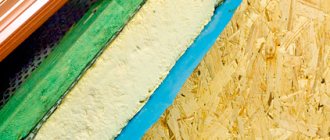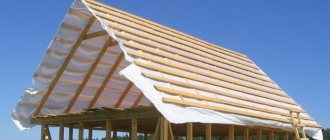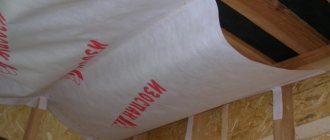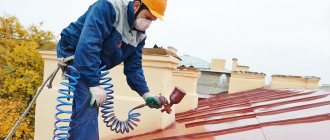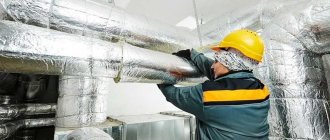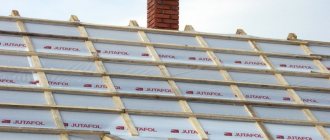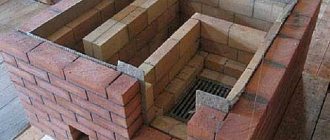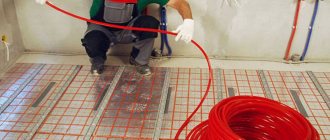Characteristics and differences
Izospan is a non-woven building material. It is produced in the form of films and membranes, which are designed to protect and insulate surfaces. Izospan goes on sale in rolls.
Materials are divided into three groups:
- Windproof. This includes all insulators marked with the letter A. They are needed to retain internal heat and prevent winds from blowing through the insulation. The material does not allow moisture to pass through, but is capable of removing evaporation.
- Fully waterproofing. They are marked with the letters B, C, D. And they do not allow water or evaporation to pass through.
- Energy saving. They are marked with the letter F. They have the same characteristics as the previous group, but have a metallized reflective layer.
From the above it can be understood that only the first group has the ability to pass steam. It is precisely this that should be used to insulate residential premises, since all living organisms emit fumes into the atmosphere. And if the liquid in the form of steam is not able to leave the room, then the humidity in it will soon rise critically.
Types of vapor barrier Source stroychik.ru
The remaining groups are solid insulators. But the latter has a thin metal coating that can reflect heat, preventing it from leaving the room. This feature requires an air gap between the mirror layer and the other material. It must be at least 3.5 cm.
And before you think about how to properly lay Izospan, you need to fully study the brand on the product. The first letter on the marking is often followed by others. They indicate additional insulation properties. For example, the letters M or S indicate the presence of reinforcement. And the abbreviation of small letters “fix” indicates the presence of applied strips of glue along the edges. And when buying such a product, you don’t have to worry about tape.
Useful tips
Izospan is not installed on a plastered ceiling. The reason is that the interior decoration will suffer if the membrane is on top, because moisture will accumulate under it, destroying the coating and stimulating the formation of fungus. There is no need to use foam or polystyrene foam film. The latter do not have vapor permeability, so they act as insulators.
In a room where Izospan is laid on the ceiling, ventilation is important to reduce the percentage of moisture in the air. If the material is torn in the middle during installation, the damage is sealed with construction tape or tape placed between the sheets. This is done in two or three layers so that the cut does not spread when the membrane is pulled. The installation process is clearly shown in the video below.
Izospan A
The material is produced in the form of a diffusion membrane, which is capable of completely retaining any liquid. But evaporation passes through it easily. Therefore, if it is positioned correctly, it serves as reinforcement and protection of thermal insulation. It also does not allow the latter to accumulate moisture from evaporation coming from the room.
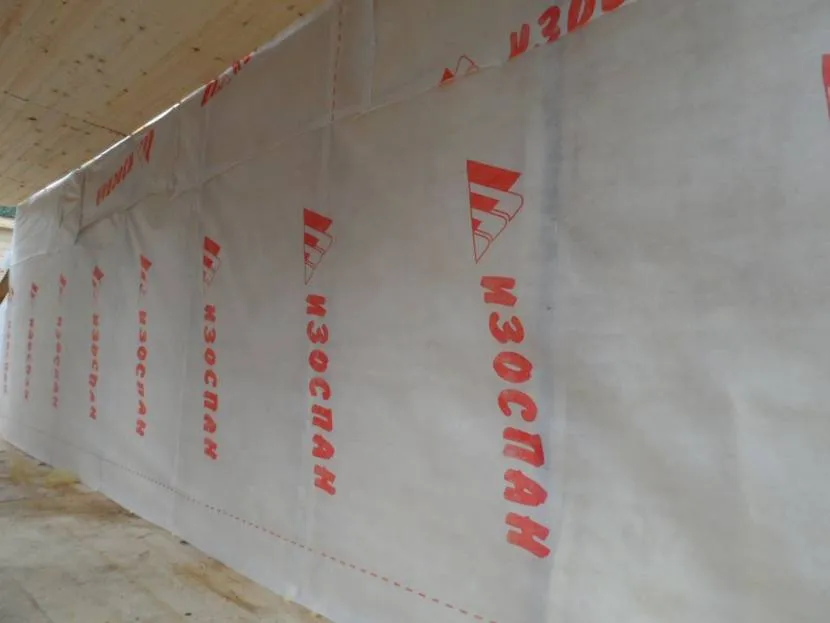
Vapor barrier marked A Source roofing façade34.rf
The exception is Izospan A (base). This material serves only as a wind barrier and, in addition to steam, it also allows moisture to pass through. It is used to insulate the ceiling located above the facade, in which there is good air circulation. Place the membrane on top of the mineral wool, on the subfloor side. And it allows the insulation to get rid of not only steam, but also water.
The temperature range for operating the material is quite wide. The insulator can be used from severe frosts of -60 °C to serious heat of +80 °C. Izospan A is able to retain its characteristics even when exposed to ultraviolet radiation. But the truth is only for 3-4 months. Then a sharp decline in performance begins.
The insulator is able to withstand a fairly large tensile load, and some materials even have fire-fighting properties. Based on these parameters, group with the letter A is best used for ventilated facades and frame-type enclosing structures. Also for a roof that has double sheathing and a slope of at least 35 degrees.

Waterproofing for metal tiles Source stoydiz.ru
See also: Catalog of companies that specialize in home insulation
Basic rules for working and instructions on which side to lay Izospan A to the insulation:
- The material on the wall begins to be mounted from below.
- The same sequence must be maintained when working on a pitched roof.
- On horizontal roofs, Izospan is laid starting from any of the walls.
- The next panel must be laid with an overlap on the previous one. Ten centimeters are enough on the walls, and ceilings and roofs should have at least fifteen centimeters.
- If there are no adhesive strips on the edges, then all connections are fixed using double-sided tape.
- For a clearer connection to the rafter system, it is better to use a special sealing tape.
- For material with clear markings (only one letter A), it makes no difference which side the insulator is applied to the insulation.
- Izospan, which has double markings (AS, AM and others), must be unfolded so that the logo is on the outside.
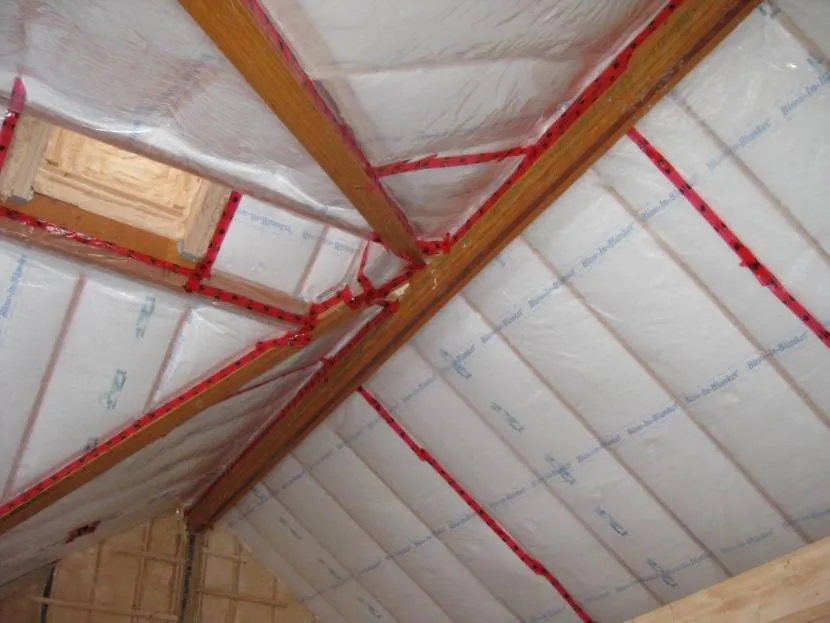
The last point is very important.
If you make a mistake, fumes will begin to accumulate in the insulation. It will get wet, which will lead to the loss of its positive properties. The process will speed up significantly when moisture begins to partially penetrate from the outside as the other side allows steam to pass through. And there is enough vapor everywhere.
Side material
Izospan B is standardly used for various ceilings and is placed between the rough and finishing layers to protect the thermal insulation layer. If it is applied from the side of the room, then the fleecy side “looks” inward, and the smooth side is placed on the rough version of the ceiling.
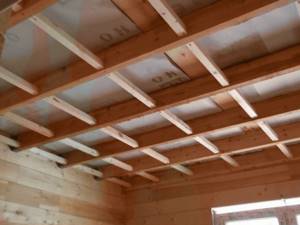
Experts do not see any fundamental significance whether the overlapping strips are fastened using a stapler, hammer and nails with wide heads or they are sealed with self-adhesive tape. The main condition for securing the obtained result is padded slats or a special durable galvanized profile.

A decorative layer is attached to this frame - it can be drywall, lining or plywood. The main thing is to provide a ventilation gap of at least 5 cm between the layers. The ceiling of a bathhouse or other functional room may require special ventilation holes designed for pipes.
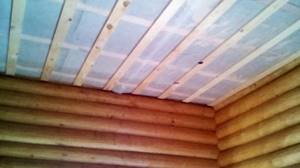
Here additional precautions are taken: holes of the required diameter are cut out in the canvas, which are then covered with an additional layer using a special tape or, in extreme cases, adhesive tape for sealing.
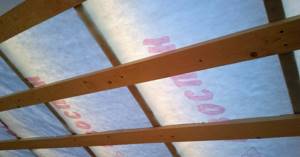
Izospan B
Unlike the previous material with a mark in the form of the letter A, all other markings are vapor barriers. And since they do not allow evaporation to pass through, they completely protect the insulation from moisture. Therefore, Izospan is placed in front of the insulation, and not behind it, as in the previous case. This is if you look at it from the room. They are produced in the form of film, and it is usually two-layer.
Izospan marked B, consisting of polypropylene, is used to strengthen the ceiling insulation and protect it from moisture. The material has the same temperature range for use as Izospan A. The characteristics of water resistance and ultraviolet resistance are also the same.
In order to understand how to properly lay Izospan with such markings, you need to carefully examine the sides of the material. One of them is perfectly smooth. On the other there are the smallest fibers. So they do not allow moisture to accumulate on the walls.
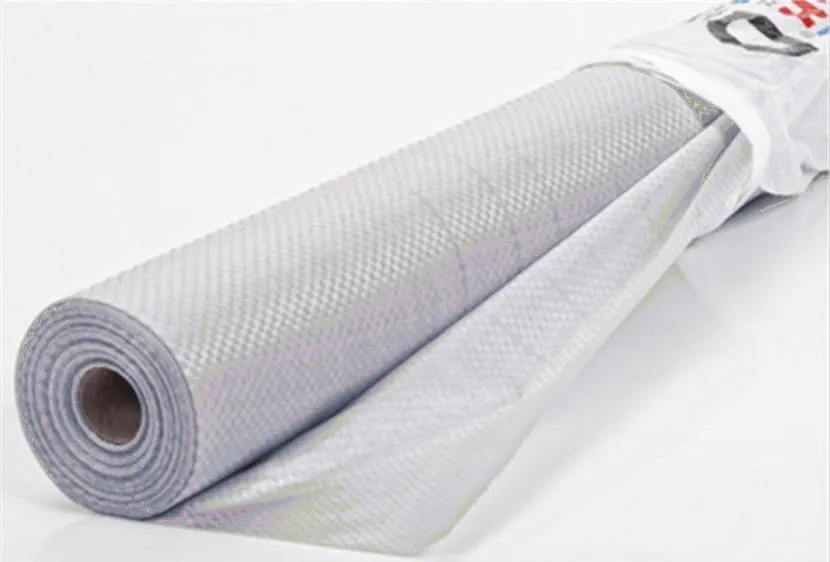
Izospan B Source opotolkax.com
The lint on the surface helps water roll down quickly. Therefore, the smooth side of the material should be adjacent directly to the insulation, without any gaps. The latter is necessary before a rough surface. Otherwise, moisture will not be able to move down.
Laying vapor barrier depending on the direction of movement of warm air
For proper installation of vapor barrier material, it is necessary to take into account the direction of moist warm air. From the school physics course, everyone knows that steam is always directed towards the side with lower pressure. For example, indoor air pressure is always higher than in the attic, therefore, steam will tend towards the attic. A similar situation occurs in the attic, where the pressure is higher than in the atmosphere. Here, air with suspended water particles will rise to the roof slopes. In other words, steam always tends from the living space to the attic, and from there it tries to pass out through all the layers of the roofing pie.
When passing through the roofing system, a certain amount of vapor remains in the materials of the roofing system, having a negative impact on its individual elements. To prevent this process, it is necessary to use a vapor barrier when insulating the ceiling. If the attic is not insulated, then a barrier to the path of steam is installed on the inside of the living space in front of the insulation, becoming its direct protection.

Laying a vapor barrier layer on the top floor is carried out taking into account the purpose of the attic space:
- If the attic is not intended to be used, then a vapor barrier is installed only along the ceiling. Insulation in this case does not need waterproofing and protection from the wind. However, do not forget about waterproofing the slopes to prevent the penetration of precipitation.
- If you plan to spend summer holidays in the attic, storing things and supplies, then the insulation should be covered with a vapor barrier film on both sides. The slopes are also provided with protection from atmospheric moisture.
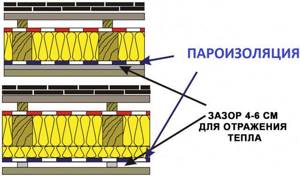
It should be noted that to protect structural elements from moisture, not only a vapor barrier layer is used. For this purpose, ventilation is installed, vents are installed, aerators and a ventilated ridge are installed. Ceiling vapor barrier in a private house is one aspect of a complex undertaking; it can flawlessly perform its function if the roof is properly installed.
Izospan C, D
Marking C indicates that the material is well suited for insulating insulation under the roof. It is often used instead of a waterproofing substrate under metal tiles. It is also laid when arranging concrete floors in places where humidity exceeds specified standards.
Marking D indicates that the insulator has good UV resistance. This circumstance and the fact that the material has greater strength allows it to be used as a temporary roof. Otherwise, it is used like the previous insulator.
There is no need to guess which side to lay the Izospan with these markings on. The materials also have a rough surface on one side. So she should look into the room. And the smooth side must be adjacent to the insulation.

Stages of vapor barrier installation Source krepezhinfo.ru
Izospan F
A distinctive feature of an insulator marked F is a metallized layer on one of the surfaces. It allows you to reflect the heat coming from the room back. This ability not only enhances the characteristics of the insulation, but also allows you to maintain a favorable atmosphere for as long as possible.
Izospan F is also used as a vapor barrier and is used in the same places as materials marked B or C. But it is more widespread to enhance the characteristics of heated floors. And the layout is as follows.
First, insulation is laid on the floor slabs. Then the vapor barrier is laid with the reflective layer facing up. After this, the heating system is installed. In this case, moisture does not penetrate downwards, and the insulation retains its characteristics. And the underfloor heating system does not heat the ceiling of the neighbors, but transfers all the heat into the room.
Reasons for making a pie
One of the arguments in favor of constructing a pie is the vapor permeability of building materials, that is, their ability to pass warm air with the smallest particles of steam. If this property is not taken into account, then moisture will accumulate in the thermal insulation layer, which makes up the main part of the multilayer system, which will have a destructive effect on all structural elements.
A correctly selected vapor barrier material can completely eliminate the penetration of steam or reduce it as much as possible. It all depends on the vapor permeability, which should have minimum values.
When using materials that still allow moist warm air to pass through, you should choose the right thermal insulation and waterproofing. In such a situation, the throughput of these materials must be significantly higher in order to actively conduct moist air, preventing moisture from stagnating in the layers of the roofing pie.
Briefly about the main thing
To work correctly with Izospan, you must carefully study the instructions, as well as the product labeling. How fully the insulation will perform its functions will depend on which side the insulator is adjacent to the insulation. An error in location will cause the heat insulator to quickly fail.
Loss of the positive characteristics of the insulation will lead to the formation of an atmosphere in the room unsuitable for life. Expensive repairs will be required. After all, you will have to open the walls and completely change both insulators.
Ratings 0
